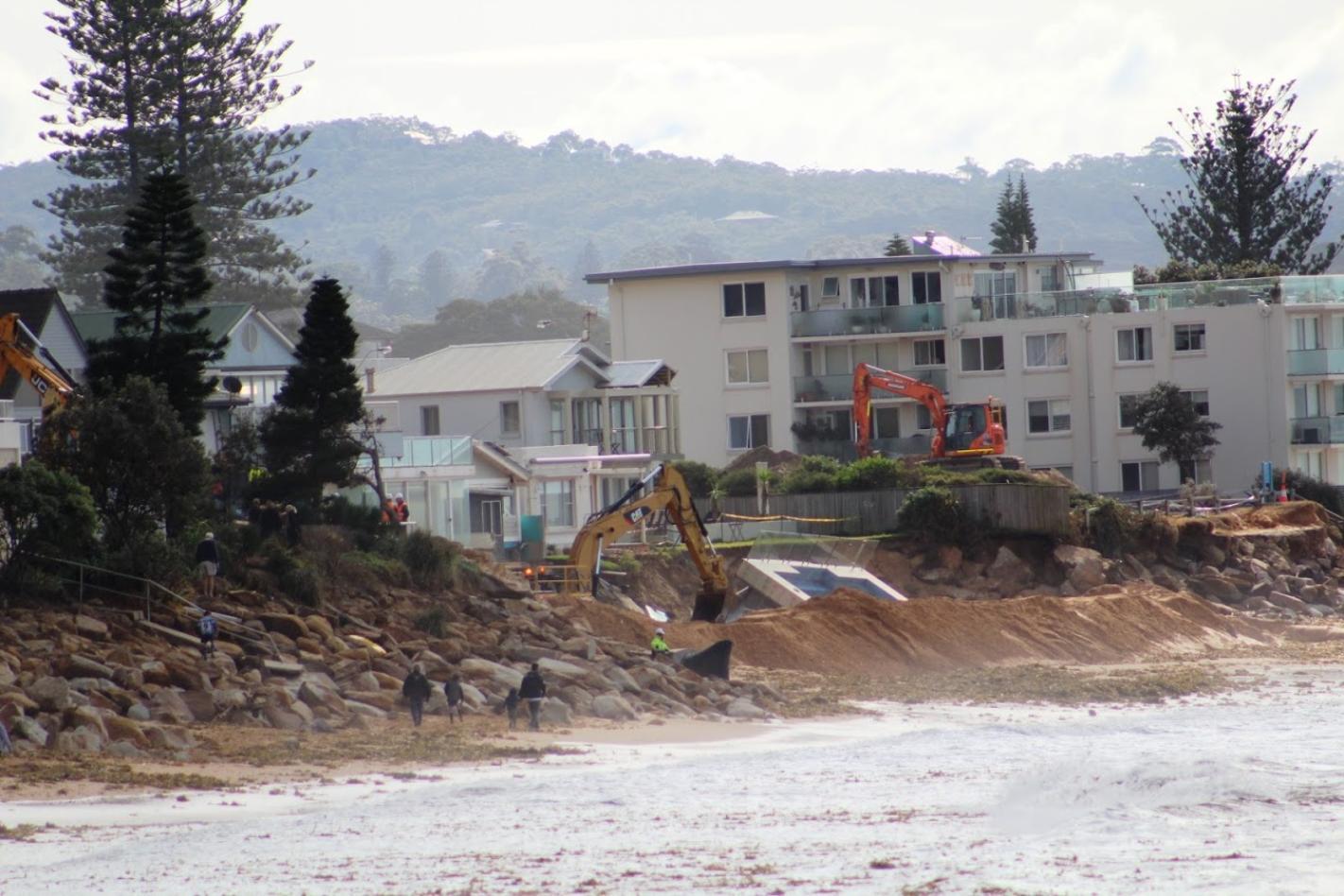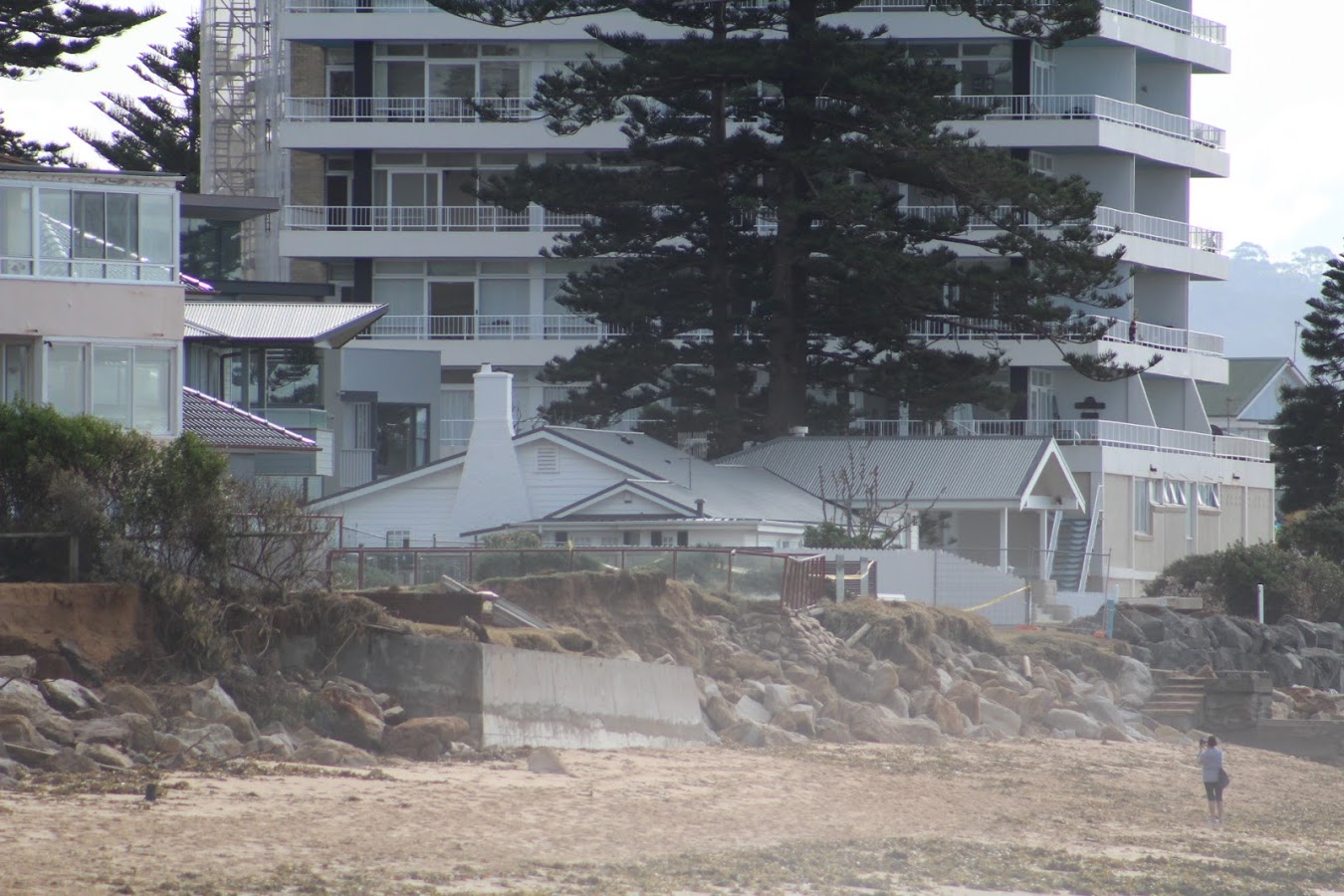March 8 - 14, 2020: Issue 441
World’s Sandy Beaches Under Threat From Climate Change

Collaroy beachfront after June 2016 storms - A J Guesdon photo
March 2, 2020:
Half of the world's beaches could disappear by the end of the century due to coastal erosion, according to a new study led by the JRC. Erosion is a major problem facing sandy beaches that will worsen with the rising sea levels brought about by climate change. According to the study, published today in Nature Climate Change, effective climate action could prevent 40% of that erosion.
Sandy beaches cover more than 30% of the world’s coastlines. They are popular recreational spots for people and they provide important habitats for wildlife. They also serve as natural buffer zones that protect the coastline and backshore coastal ecosystems from waves, surges and marine flooding.
Their role as shock absorbers will become more important with the rising sea levels and more intense storms expected with climate change.
However, climate change will accelerate erosion and could make more than half of the world’s sandy beaches completely vanish by the end of this century.
Fuelled by a growing population and urbanisation along coastlines, this is likely to result in more people’s homes and livelihoods being impacted by coastal erosion in the decades to come.
The findings come from the first global assessment of future sandy shoreline dynamics.
JRC scientists combined 35 years of satellite coastal observations with 82 years of climate and sea level rise projections from several climate models.
They also simulated more than 100 million storm events and measured the resulting global coastal erosion.
They found that reducing greenhouse gas emissions could prevent 40% of the projected erosion.
However, even if global warming is curbed, societies will still need to adapt and better protect sandy beaches from erosion.
This is one of the main messages of the Paris Agreement on climate and the EU adaptation strategy.
Human presence makes sandy beaches less resilient
Sandy coastlines are extremely dynamic environments due to altering wave conditions, sea levels and winds, as well as geological factors and human activity.
They are naturally resilient to climate variations, as they can accommodate higher seas and marine storms by retreating and adapting their morphology.
However, they face more and more pressure because of human development, a situation that could become worse if contemporary coastal urbanisation and population growth continues.
As "backshores" – the area of a coastline above the high-tide level - become increasingly built-up, sandy shorelines are losing their natural capacity to accommodate or recover from erosion.

Collaroy beachfront after June 2016 storms - A J Guesdon photo
At the same time, river dams and human developments retain sediment upstream that would naturally feed beaches.
As a result, a substantial proportion of the world’s sandy coastlines are already eroding, a process that could accelerate with rising sea levels.
Climate mitigation and adaptation challenges ahead
The study shows that without climate mitigation and adaptation almost half of the world’s sandy beaches are under threat of near extinction by the end of the century.
Apart from the loss of valuable ecosystems, socioeconomic implications can be severe, especially in poorer, tourism dependent communities where sandy beaches are the main tourist attraction. Small island nations are among the more vulnerable regions.
In most parts of the world, projected shoreline dynamics are dominated by sea level rise and moderate greenhouse gas emission mitigation could prevent 40% of shoreline retreat globally.
Yet, in certain regions the effects of climate change are counteracted by "accretive ambient shoreline changes" - the build-up of sandy beaches from sediments arriving due to other natural or anthropogenic factors.
This is true for areas of the Amazon, East and Southeast Asia and the North Tropical Pacific.
Commission is already working to address these challenges
The EU is committed to mitigating climate emissions. With the Green Deal for Europe it strives to achieve carbon neutrality by 2050.
The EU Strategy on Adaptation to Climate Change aims to make Europe more resilient and minimise the impact of unavoidable climate change.
It stresses that coastal zones are particularly vulnerable to the effects of climate change, which challenges the climate resilience and adaptive capacity of our coastal societies.
This requires a strong EU Strategy and preparedness actions by Member States aimed at reducing the vulnerability of their citizens and economies to coastal hazards in order to minimize future climate impacts in Europe.
The EC published the recommendations for Integrated Coastal Management. This policy instrument requires establishing a coastal setback zone, extending at least 100 m landward from the highest winter waterline, taking into account, inter alia, the areas directly and negatively affected by climate change and natural risks.
The EC Floods Directive requires Member States to assess if all water courses and coastlines are at risk from flooding, to map the flood extent and assets and humans at risk in these areas and to take adequate and coordinated measures to reduce this flood risk.
Maintaining healthy sandy beaches is an effective coastal protection measure, and has environmental benefits.
Several sandy environments are included in the EC Habitats Directive as they are related to protected species and many of the NATURA protected areas include sandy coastlines.
Implementation of these actions should lead to rivers being more able than they are now to resume their natural function of sediment transport which, simply put, provides the material for natural processes to restore and retain sandy beaches.
The Sendai Framework for Disaster Risk Reduction 2015-2030, the Paris Agreement on Climate Change and the Sustainable Development Goals have set the agenda for reducing disaster risks through sustainable and equitable economic, social, and environmental development.
In this context, poorer low-lying countries remain particularly vulnerable to coastal hazards and huge investments or changes in these societies may be needed to close the vulnerability gap with richer countries.
Michalis I. Vousdoukas, Roshanka Ranasinghe, Lorenzo Mentaschi, Theocharis A. Plomaritis, Panagiotis Athanasiou, Arjen Luijendijk, Luc Feyen. Sandy coastlines under threat of erosion. Nature Climate Change, 2020; 10 (3): 260 DOI: 10.1038/s41558-020-0697-0
The World May Lose Half Its Sandy Beaches By 2100. It’s Not Too Late To Save Them
March 3, 2020
A new study has reported the world will lose almost half of its valuable sandy beaches by 2100 as sea levels rise. But cutting our emissions could keep some intact.
For many coastal regions, sea-level rise is a looming crisis threatening our coastal society, livelihoods and coastal ecosystems. A new study, published in Nature Climate Change, has reported the world will lose almost half of its valuable sandy beaches by 2100 as the ocean moves landward with rising sea levels.
Sandy beaches comprise about a third of the world’s coastline. And Australia, with nearly 12,000 kilometres at risk, could be hit hard.
This is the first truly global study to attempt to quantify beach erosion. The results for the highest greenhouse gas emission scenario are alarming, but reducing emissions lead to lower rates of coastal erosion.
Our best hope for the future of the world’s coastlines and for Australia’s iconic beaches is to keep global warming as low as possible by urgently reducing greenhouse gas emissions.
Losing sand in coastal erosion
Two of the largest problems resulting from rising sea levels are coastal erosion and an already-observed increase in the frequency of coastal flooding events.
Erosion during storms can have dramatic consequences, particularly for coastal infrastructure. We saw this in 2016, when wild storms removed sand from beaches and damaged houses in Sydney.
After storms like this, beaches often gradually recover, because sand from deeper waters washes back to the shore over months to years and in some cases decades. These dramatic storms and the long-term sand supply make it difficult to identify any beach movement in the recent past from sea-level rise.
What we do know is that the rate of sea-level rise has accelerated. It has increased by half since 1993, and is continuing to accelerate from ongoing greenhouse gas emissions.
If we continue to emit high levels of greenhouse gases, this acceleration will continue through the 21st century and beyond. As a result, the supply of sand may not be able to keep pace with rapidly rising sea levels.

Collaroy beachfront after June 2016 storms - A J Guesdon photo
Projections for the worst-case scenario
In the most recent Intergovernmental Panel on Climate Change (IPCC) report, released last year, the highest greenhouse gas emissions scenario resulted in global warming of more than 4°C (relative to pre-industrial temperatures) and a likely range of sea-level rise between 0.6 and 1.1 metres by 2100.
For this scenario, this new study projects a global average landward movement of the coastline in the range of 40 to 250 metres if there were no physical limits to shoreline movement, such as those imposed by sea walls or other coastal infrastructure.
Sea-level rise is responsible for the vast majority of this beach loss, with faster loss during the latter decades of the 21st century when the rate of rise is larger. And sea levels will continue to rise for centuries, so beach erosion would continue well after 2100.
For southern Australia, the landward movement of the shoreline is projected to be more than 100 metres. This would damage many of Australia’s iconic tourist beaches such as Bondi, Manly and the Gold Coast. The movement in northern Australia is projected to be even larger, but more uncertain because of ongoing historical shoreline trends.
What happens if we mitigate our emissions
The above results are from a worst-case scenario. If greenhouse gas emissions were reduced such that the 2100 global temperature rose by about 2.5°C, instead of more than 4°C, then we’d reduce beach erosion by about a third of what’s projected in this worst-case scenario.
Current global policies would result in about 3°C of global warming. That’s between the 4°C and the 2.5°C scenarios considered in this beach erosion study, implying our current policies will lead to significant beach erosion, including in Australia.
Mitigating our emissions even further to achieving the Paris goal of keeping temperature rise to well below 2°C would be a major step in reducing beach loss.
Why coastal erosion is hard to predict
Projecting sea-level rise and resulting beach erosion are particularly difficult as both depend on many factors.
For sea level, the major problems are estimating the contribution of melting Antarctic ice flowing into the ocean, how sea level will change on a regional scale, and the amount of global warming.
The beach erosion calculated in this new study depends on several new databases. The databases of recent shoreline movement used to project ongoing natural factors might already be influenced by rising sea levels, possibly leading to an overestimate in the final calculations.
The implications
Regardless of the exact numbers reported in this study, it’s clear we will have to adapt to the beach erosion that we can no longer prevent, if we are to continue enjoying our beaches.
This means we need appropriate planning, such as beach nourishment (adding sand to beaches to combat erosion) and other soft and hard engineering solutions. In some cases, we’ll even need to retreat from the coast to allow the beach to migrate landward.
And if we are to continue to enjoy our sandy beaches into the future, we cannot allow ongoing and increasing greenhouse gas emissions. The world needs urgent, significant and sustained global mitigation of greenhouse gas emissions.
John Church, Chair Professor, Climate Change Research Centre, UNSW
This article is republished from The Conversation under a Creative Commons license. Read the original article.

Collaroy beachfront after June 2016 storms - A J Guesdon photo